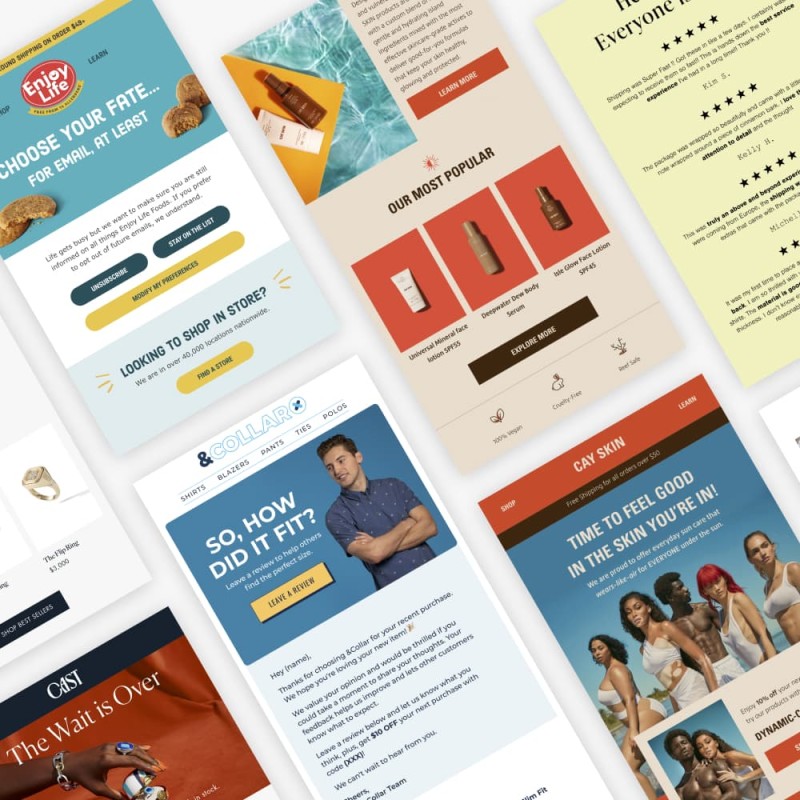How to Optimize Email Flows: Klaviyo Best Practices

Quick Summary Running successful email marketing campaigns can take a lot of effort. But when it is done right, email marketing is a great way to gain new customers, stay connected with your loyal fan base, and increase customer retention.
The right email service provider can help you do all of that while saving you time and making your email processes more efficient. Klaviyo is an email marketing platform that was built for retail and e-commerce. With features such as advanced segmentation, the ability to create customer profiles, and real-time reporting on customer activity, Klaviyo lets you deliver customized experiences to your consumers.
Klaviyo also enables you to create automated email flows that trigger personalized messages based on your customers' actions. Whether you are reminding a shopper about items left in their cart or sending a personalized note to thank someone for their purchase, Klaviyo's email flows allow you to easily stay in touch with your customers. All you need to do is create then monitor your campaigns to track what’s landing sales and what isn’t.
If you are already using Klaviyo's email flows but aren't getting the results you want, you may need to optimize them. Optimizing your email flows means analyzing their performance metrics and improving upon the areas that haven't been successful to drive more sales for your business. In this article, we'll show you how to increase the open rates, conversion rates, and click-through rates (CTRs) for your email flows.
Recommended Klaviyo Flows
Klaviyo's email flows are designed to reach customers at various stages of their buying journeys. They can be customized to display targeted messages for each consumer.
The four recommended email flows for e-commerce and retail businesses are:
Welcome series - introduce new subscribers to your brand and turn them into customers
Abandoned cart - remind customers that there are items in their cart that haven't been purchased
Browse abandonment - reach out to customers that have browsed your website but did not make a purchase
Thank you series - thank customers for their purchase after a confirmation email has been sent
Reviewing Your Email Analytics
If you've been using the same flows for a while, you should optimize them to prevent your emails from becoming stale. To identify the areas that need improvement, analyze your performance with Klaviyo's campaign reports.
You should review the following metrics for each email you send:
1. Open rates
An open rate is the percentage of people who open your emails. High email open rates indicate that your subject lines are working and people want to open your emails. Low open rates could mean that your subscribers aren't resonating with your subject lines and aren't interested in opening your emails.
2. Click-through rates
Your CTR is the percentage of people who click at least one link in your email. If you have high open rates but low CTRs, it could be a sign that your email content needs improvement or that your emails lack a clear call to action (CTA).
3. Conversion rates
Email conversion rates tell you how often subscribers turn into customers. These are the people who make a purchase or complete an action on your site after engaging with your emails.
4. Delivery rates
Email delivery rates are the percentages of people who successfully received your email. A low delivery rate can indicate that your emails are bouncing, meaning that they are not being delivered to your subscribers.
How to Optimize Klaviyo Flows
To drive more sales and increase revenue from your emails, you need to draw in subscribers with content that convinces them to open your emails and click the links. Follow the steps below to help boost the performance of your email flows.
1. Update your email subject lines
A strong subject line can spark curiosity and encourage the recipient to open your email. A bad subject line can result in the recipient ignoring your message. Even worse, the email could wind up in a subscriber's spam folder.
If your open rates are below your industry's benchmarks, conduct A/B testing to identify which of your subject lines perform best. Test light-hearted, witty lines against more serious ones. Try subject lines with and without emojis. Experiment with personalized versus non-personalized lines. Once you know which ones perform better, you can update future subject lines to help improve your open rates.
When updating them, you should also avoid common spam triggers such as excessive use of punctuation marks or writing in all caps.
2. Switch up your content
Has it been several months since you updated your email content? Are you personalizing your emails? Is the content relevant to your subscribers' interests?
If your emails feature the same products over and over again, your subscribers will eventually know what to expect from you, and they'll stop opening your emails. Make sure your emails regularly feature new content so your subscribers have something exciting to look forward to.
Personalization can also boost your email performance by making your subscribers feel special. Share dynamic content that is catered to each individual's interests. Additionally, consider setting up birthday flows so that you can send celebratory messages to your subscribers on their birthdays.
You should also review your call to action. Strong email CTAs can determine whether your subscribers click your links or scroll past them. If you have high open rates but low CTRs, your CTAs may not be compelling or clear enough. Use action-oriented words such as "shop now" or "add to basket" and avoid vague phrases like "click here."
See how we launch & scale brands on Shopify Plus with a data-backed approach
3. Create new segments.
In Klaviyo, you can group your contacts into different categories by creating segments. Segments allow for more advanced personalization by enabling you to target specific customers with your email content.
For instance, you can create segments for customers who have spent a certain dollar amount on your products, or for customers who are subscribed to your emails but haven't made a purchase in over six months.
Klaviyo also allows you to create segments for low-CLV (customer lifetime value) users. These are customers who only buy products when you offer sales or discount codes. Creating a specific segment for them can help increase the conversion rate for those emails.
4. Offer new discounts and promotions
In addition to changing your content, you should regularly offer new discount codes and sales on new items. Make sure you can still turn a profit before offering discounts, however, and test them on a small percentage of your customers before sending them to everyone.
Klaviyo offers A/B testing for discounts and coupons as well, so you can analyze what kind of discounts excite your subscribers the most. A 5% discount may not garner much attention, but a 25% discount should spark more interest.
5. Experiment with send times.
While there are guidelines for the best days and times to send emails, the ideal send times for your customers may vary. Your subscribers may be more likely to check their emails on a Thursday night as opposed to a Tuesday afternoon.
Send emails on different days and at different times to find what works best. You can perform A/B testing for your send times just like you can for subject lines and discounts. If you have more than 12,000 subscribers, you can also use Klaviyo's Smart Send Time tool to discover the ideal times for your customers.
6. Clean your lists.
If you've tried all of these strategies and your open rates or CTRs are still low, it may be time to review your lists and remove subscribers who don't engage with your emails.
You'll first need to create a segment of unengaged subscribers. Identify the customers who are subscribed to your emails but don't open them or click any links. Determine whether you'd like to suppress or delete them. If you delete them, all of their data will be permanently removed from Klaviyo. If you suppress them, their data will remain in Klaviyo, but they will no longer receive your emails.
Before removing any contacts, consider creating a sunset flow. This will allow you to engage with them one more time. If they still don't respond, you can suppress or delete them from your mailing list.
You should also look at the subscribers whose emails frequently bounce. Bounces can either be hard or soft. Hard bounces occur when an email address is misspelled or invalid. Soft bounces occur for temporary reasons, such as when a recipient's email server is down. Klaviyo will automatically suppress hard bounces. Soft bounces are suppressed after they've bounced more than seven times in a row. However, it is still recommended to segment email addresses that soft bounce more than four times from your campaigns.
Getting Started
Optimizing Klaviyo flows takes some work, but by analyzing your data and tweaking your emails, your email marketing strategy can become more successful and less time-consuming. Contact Avex Designs if you have any questions about your email flows or would like to discuss more email marketing tips.



